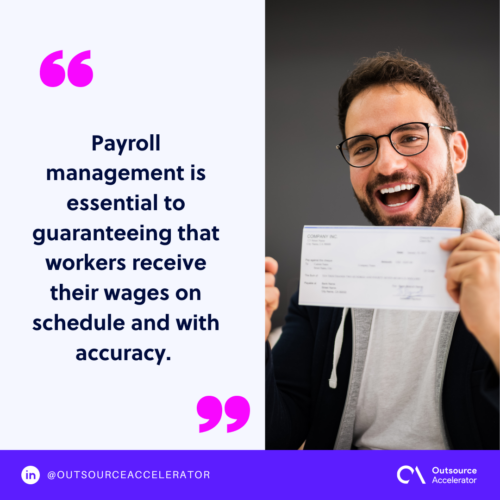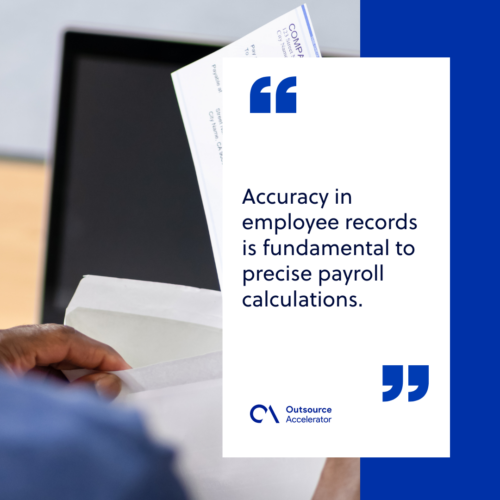A complete guide to payroll management

Payroll management is crucial to the success of any organization. It weaves together the financial well-being of both organizations and their employees.
As the heartbeat of an organization’s financial rhythm, an efficient payroll management system is essential to maintain employee satisfaction and compliance with legal requirements.
In this article, we’ll explore the role of payroll management, its types, benefits, and essential steps.
What is payroll management?
Payroll management is the systematic administration of employee financial records. This includes the following elements:
- Salaries
- Wages
- Bonuses
- Deductions
- Taxes
Payroll management is essential to guaranteeing that workers receive their wages on schedule and with accuracy. It fulfills legal obligations to government agencies and keeps financial records organized.
The process plays a pivotal role in maintaining employee satisfaction, fostering regulatory compliance, and contributing to the company’s overall financial health.

Types of payroll management
There are several types of payroll management systems, each tailored to meet the unique needs of different organizations.
Here are the three primary types:
In-house payroll management
This traditional approach has businesses handle payroll management internally using their own resources. These usually take the form of dedicated payroll personnel or HR staff.
This method allows for more direct control and customization of the process. However, it requires significant investment in technology, training, and resources.
Cloud-based payroll management
Modern payroll management often leverages cloud-based software. This type of software enables organizations to automate payroll calculations, generate pay slips, and handle tax filings more efficiently.
Cloud-based payroll management systems can be accessed from anywhere, providing flexibility and scalability as the organization grows.
Outsourced payroll management
Many organizations opt to outsource payroll management to third-party service providers. These companies specialize in handling all aspects of payroll administration.
Outsourcing payroll management allows businesses to save time, reduce administrative burdens, and ensure compliance. It also gives them access to professional expertise and advanced technology.
Outsourced offers you a dedicated team of remote payroll processors as an alternative to in-house employees.
The choice of payroll management approach depends on factors like size, budget, and complexity of payroll requirements. Each system has its advantages and challenges that organizations must consider.
Some minor types of payroll management systems are:
- Manual payroll management – This is a traditional approach that involves manual calculation and processing. While simple, it can be time-consuming and prone to errors.
- Integrated HR and payroll management – Some organizations prefer integrated systems that combine payroll with other HR functions. This allows for seamless information flow between different aspects of employee management.
- Global payroll management – Multinational companies dealing with employees across various countries may adopt this system. These are designed to handle the complexities of international payroll.
- Mobile payroll management – Through this system, employees can access their pay information, submit time-off requests, and perform other tasks using mobile applications.
Benefits of proper payroll management
Payroll management brings several benefits:
Accuracy and error reduction
Accurate payroll calculations are crucial to ensure employees are paid correctly and avoid any disputes or dissatisfaction.
Proper payroll management reduces the risk of errors and results in improved employee satisfaction and trust.
Timely payroll processing
Efficient payroll management ensures that employees receive their wages on time. This heavily contributes to fostering a positive work environment and maintaining morale.
When payroll is processed promptly, it reduces the risk of financial stress for employees and enables them to focus on their tasks.
This reliability is fundamental in meeting employees’ financial obligations, supporting their livelihoods, and fostering a sense of security.
Enhance employee satisfaction
Meanwhile, payroll errors or delays can lead to dissatisfaction and demotivation and potentially damage the employer-employee relationship.
Proper payroll management acts as a cornerstone for employee contentment as it has a direct impact on their financial well-being and satisfaction.
It creates a positive work environment that underpins the overall success and sustainability of the organization.

Boost employee trust and morale
Payroll management contributes to building trust and morale among the workforce.
When workers have confidence that their compensation is handled precisely and transparently, it enhances their commitment to the company.
Legal compliance
Payroll management includes adhering to various legal and regulatory requirements.
By ensuring that these obligations are met, payroll management reduces the risk of penalties, fines, or legal consequences for the organization.
Cost savings
Effective payroll management can lead to cost savings through reduced errors, efficient use of resources, and avoidance of penalties.
These savings assist in the financial well-being of the company.
Financial reporting and analysis
Accurate payroll management generates financial data that is essential for financial reporting and analysis.
Properly managed systems can provide insights into:
- Labor costs
- Tax liabilities
- Benefits expenses
This information supports budgeting, forecasting, and decision-making processes.
12 steps to payroll management
Systematic payroll management involves a series of well-defined steps to ensure accuracy, compliance, and efficiency.
While specific processes may vary based on the organization, here is a general outline of the typical steps involved in payroll management:
1. Verify employee information
Begin by gathering necessary employee information, including the following:
- Employee details
- Tax withholding forms
- Banking information for direct deposits
- Relevant employment contracts
Ensure that these employee records are complete and accurate.
2. Track time and attendance
Keep track of employee attendance, working hours, leaves, overtime, and other relevant time-related data. This can be done through manual timesheets, time-tracking tools, or automated attendance systems.
Accurate time records are crucial in payroll management for calculating wages and overtime payouts.
3. Calculate gross pay
Calculate the gross pay for each employee based on the information gathered from time and attendance records. Consider any additional payments or bonuses as well.
Take into account applicable state and federal labor laws, wage rates, and overtime regulations when calculating.
4. Deductions and withholdings
Deduct appropriate amounts from gross pay for taxes, insurance premiums, retirement contributions, and other authorized deductions. The employee may also voluntarily request deductions for other purposes.
Ensure compliance with tax regulations at local, state, and federal levels.
The resulting sum is the net pay, which is the amount the employee will receive.
5. Payroll processing
Prepare and process payroll payments to employees. This step of payroll management involves inputting the calculated data, ensuring all components are correctly accounted for, and generating payments and transfers.
6. Review and verification
Conduct a thorough review of the payroll before finalizing payments. Verify calculations, deductions, and employee information to identify and rectify any errors or discrepancies.
7. Payment distribution
Consider any preferred payment methods when disbursing payroll (such as through direct deposit or physical cheques).
Make sure to follow established payment schedules and deadlines.
8. Communicate payroll information to employees
Clearly communicate payroll-related information to employees, including pay stub details, tax-related documents, and any changes in policies or procedures. Generate payroll reports for this purpose.
Address any queries or concerns promptly. Be sure to keep records of payroll data for future reference and audit purposes.
9. Tax filings and reports
File payroll tax reports (such as Form 941 in the United States) as required by tax authorities. Comply with relevant regulations and timely submission of payroll tax payments.
10. Reconcile payroll accounts
Reconcile payroll accounts to verify the accuracy of payroll transactions.
This involves reviewing and analyzing payroll reports, comparing them with financial records, and resolving any discrepancies or errors. This proactive approach helps identify and rectify issues before external audits.
11. Compliance and regulation adherence
Stay informed and compliant with any changes in payroll laws, tax rates, or other regulatory requirements that may impact your payroll management processes.
Ensure that your practices align with current legal standards to avoid penalties and legal issues.
12. Continuous improvement
Regularly assess payroll processes and systems for efficiency and effectiveness. Embrace technological advancements and best practices to enhance the overall payment management workflow.
Payroll management tips to remember
Here are some payroll management tips to keep a smooth functioning of your processes:
- Stay organized. Set up a systematic process for collecting and maintaining employee payroll records. Accuracy in employee records is fundamental to precise payroll calculations.

- Invest in payroll software. Use dedicated payroll software that automates various tasks. The right technology can save time, reduce errors, and streamline processes.
- Keep payroll deadlines in mind. Establish and communicate clear payroll processing deadlines to ensure that all information is verified in a timely manner. Maintain a calendar or reminder system if needed.
- Maintain data security. Safeguard employee payroll data by implementing robust cybersecurity measures.
- Train and educate payroll staff. Provide ongoing training to payroll staff to keep them equipped to handle complexities in payroll management.
- Implement cross-checking procedures. Introduce cross-checking procedures to verify calculations and data at multiple stages.
- Plan for contingencies. Develop contingency plans for unexpected situations, such as system failures, natural disasters, or other disruptions.
- Seek professional advice if needed. When in doubt, seek advice from financial and legal professionals. Consider outsourcing your payroll functions.
- Regularly evaluate payroll providers. If using an outsourced payroll provider, regularly assess their performance, accuracy, and compliance with service level agreements (SLAs).
Mastering payroll management
Proper payroll management is an essential aspect of any business, no matter the size. With the right tools, processes, and knowledge, managing payroll can be a streamlined and efficient process that saves businesses time and money.
By following the insights of this guide, you can avoid costly errors and improve financial stability.
Payroll management is admittedly a complex task, but when done correctly, it can be used to unlock the full range of benefits that businesses need.







 Independent
Independent




